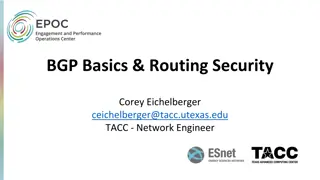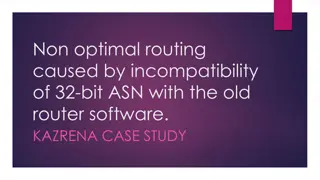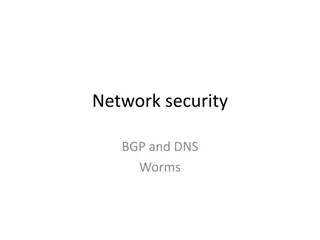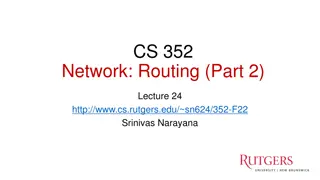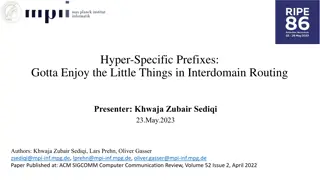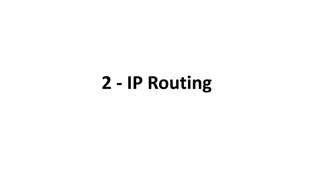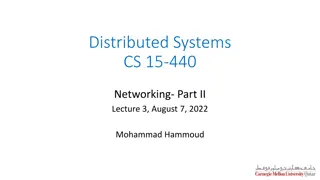Understanding BGP Protocol and Configuration for Routing Policy Filtering
Explore the terminology, reasons, and methods behind routing policy filtering in the context of BGP protocol configuration. Learn how to control traffic routing preferences, filter routes based on AS or prefix, and use regular expressions for complex filtering rules. Discover the importance of AS-Path access lists in managing inbound and outbound route announcements to optimize network performance.
Download Presentation

Please find below an Image/Link to download the presentation.
The content on the website is provided AS IS for your information and personal use only. It may not be sold, licensed, or shared on other websites without obtaining consent from the author. Download presentation by click this link. If you encounter any issues during the download, it is possible that the publisher has removed the file from their server.
E N D
Presentation Transcript
BGP Protocol & Configuration AfNOG
BGP Part 8 Routing Policy Filtering
Terminology: Policy Where do you want your traffic to go? It is difficult to get what you want, but you can try Control of how you accept and send routing updates to neighbors prefer cheaper connections, load-sharing, etc. Accepting routes from some ISPs and not others Sending some routes to some ISPs and not others Preferring routes from some ISPs over others
Routing Policy Why? To steer traffic through preferred paths Inbound/Outbound prefix filtering To enforce Customer-ISP agreements How? AS based route filtering filter list Prefix based route filtering prefix list BGP attribute modification route maps Complex route filtering route maps
Filter list rules: Regular Expressions Regular Expression is a pattern to match against an input string Used to match against AS-path attribute ex: ^3561_.*_100_.*_1$ Flexible enough to generate complex filter list rules
Regular expressions (cisco specific) ^ $ matches end _ matches start, or end, or space (boundary between words or numbers) .* matches anything (0 or more characters) .+ matches anything (1 or more characters) [0-9] matches any number between 0 and 9 ^$ matches the local AS (AS path is empty) matches start There are many more possibilities
Filter list using as-path access list Listen to routes originated by AS 3561. Implicit deny everything else inbound. Don t announce routes originated by AS 35, but announce everything else (outbound). ip as-path access-list 1 permit _3561$ ip as-path access-list 2 deny _35$ ip as-path access-list 2 permit .* router bgp 100 neighbor 171.69.233.33 remote-as 33 neighbor 171.69.233.33 filter-list 1 in neighbor 171.69.233.33 filter-list 2 out
AS-Path acts on a Network as-path access-lists work for both IPv4 and IPv6 because it performs a match for an ASN. That means that it works equally well for IPv4 and IPv6.
Policy Control Prefix Lists Per neighbor prefix filter incremental configuration High performance access list Inbound or Outbound Based upon network numbers (using CIDR address/mask format) First relevant allow or deny rule wins Implicit Deny All as last entry in list
Prefix Lists Examples Deny default route ip prefix-list Example deny 0.0.0.0/0 Permit the prefix 35.0.0.0/8 ip prefix-list Example permit 35.0.0.0/8 Deny the prefix 172.16.0.0/12, and all more-specific routes ip prefix-list Example deny 172.16.0.0/12 ge 12 ge 12 means prefix length /12 or longer . For example, 172.17.0.0/16 will also be denied. In 192.0.0.0/8, allow any /24 or shorter prefixes ip prefix-list Example permit 192.0.0.0/8 le 24 This will not allow any /25, /26, /27, /28, /29, /30, /31 or /32
Prefix Lists More Examples In 192/8 deny /25 and above ip prefix-list Example deny 192.0.0.0/8 ge 25 This denies all prefix sizes /25, /26, /27, /28, /29, /30, /31 and /32 in the address block 192.0.0.0/8 It has the same effect as the previous example In 192/8 permit prefixes between /12 and /20 ip prefix-list Example permit 192.0.0.0/8 ge 12 le 20 This denies all prefix sizes /8, /9, /10, /11, /21, /22 and higher in the address block 193.0.0.0/8 Permit all prefixes ip prefix-list Example permit 0.0.0.0/0 le 32
Policy Control Using Prefix Lists Example Configuration router bgp 200 network 215.7.0.0 neighbor 220.200.1.1 remote-as 210 neighbor 220.200.1.1 prefix-list PEER-IN in neighbor 220.200.1.1 prefix-list PEER-OUT out ! ip prefix-list PEER-IN deny 215.7.0.0/16 le 32 ip prefix-list PEER-IN permit 0.0.0.0/0 le 32 ip prefix-list PEER-OUT permit 215.7.0.0/16 ip prefix-list PEER-OUT deny 0.0.0.0/0 le 32 Accept everything except our network (and subnets) from our peer Send only our network to our peer
Prefix-lists in IPv6 Prefix-lists in IPv6 work the same way as they do in IPv4 Caveat: ipv6 prefix-lists cannot be used for ipv4 neighbours - and vice-versa Syntax is very similar, for example: ip prefix-list ipv4-ebgp permit 0.0.0.0/0 le 32 ip prefix-list v4out permit 172.16.0.0/16 ! ipv6 prefix-list ipv6-ebgp permit ::/0 le 128 ipv6 prefix-list v6out permit 2001:db8::/32
Policy Control Route Maps A route-map is like a program for Cisco IOS Has line numbers, like programs Each line is a separate condition/action Concept is basically: if match then do expression and exit else if match then do expression and exit else etc
Route-map match & set clauses Match Clauses AS-path Community IP address Set Clauses AS-path prepend Community Local-Preference MED Origin Weight Others...
Route Map: Example One router bgp 300 neighbor 2.2.2.2 remote-as 100 neighbor 2.2.2.2 route-map SETCOMMUNITY out ! route-map SETCOMMUNITY permit 10 match ip address 1 match community 1 set community 300:100 ! access-list 1 permit 35.0.0.0 ip community-list 1 permit 100:200 ! When you are sending information OUT to neighbor ! 2.2.2.2, then: if the prefix/mask matches ! access-list 1, and if the community matches ! community-list 1, then: ! do set community 300:100
Route Map: Example Two Example Configuration as AS PATH prepend router bgp 300 network 215.7.0.0 neighbor 2.2.2.2 remote-as 100 neighbor 2.2.2.2 route-map SETPATH out ! route-map SETPATH permit 10 set as-path prepend 300 300 Use your own AS number for prepending Otherwise BGP loop detection will cause disconnects
BGP Exercise 3 Filtering peer routes using AS- path regular expression
Exercise 3: Filtering peer routes using AS-path Create ip as-path access-list <number> to match your own routes ip as-path access-list 2 permit ^$ Apply the outbound filter to both upstreams neighbor <upstream-addr> filter-list 2 out
Exercise 3: What you should see From upstream: all routes To upstream: your routes, no transit
Exercise 3: Did it work? IPv4 show commands: show ip route your forwarding table show ip bgp your BGP table show ip bgp neighbor xxx received-routes from your neighbour before filtering show ip bgp neighbor xxx routes from neighbour, after filtering show ip bgp neighbor advertised-routes to neighbour, after filtering
Exercise 3: Filtering peer routes using AS-path ---- xxx to remove? Create ip as-path access-list <number> to match your own (internal) routes ip as-path access-list 1 permit ^1$ Create ip as-path access-list <number> to match your own routes ip as-path access-list 2 permit ^$ Apply the filters to both IPv4 and IPv6 peers: neighbor <address> filter-list 1 in neighbor <address> filter-list 2 out As-path filters are protocol independent, so the same filter can be applied to both IPv4 and IPv6 peers! Apply the outbound filter to the AS100 upstream neighbor <upstream-addr> filter-list 2 out
Exercise 3: Did it work? IPv6 show commands: show ipv6 route your forwarding table show bgp ipv6 your BGP table show bgp ipv6 neighbor xxx received-routes from your neighbour before filtering show bgp ipv6 neighbor xxx routes from neighbour, after filtering show bgp ipv6 neighbor advertised-routes to neighbour, after filtering
BGP Exercise 4 Filtering peer routes using prefix-lists
Exercise 4: Filtering peer routes using prefix-list (IPv4) Create ip prefix-list my-routes to match your own routes Create ip prefix-list peer-as-xxx to match your peer s routes Apply the filters to your peers neighbor xxx prefix-list my-routes out neighbor xxx prefix-list peer-as-xxx in Apply the outbound filter to your upstream provider neighbor xxx prefix-list my-routes out
Exercise 4: Filtering peer routes using prefix-list (IPv6) Create ipv6 prefix-list myv6-routes to match your own routes Create ipv6 prefix-list peer-as-xxx-v6 to match your peer s routes Apply the filters to your IPv6 peers neighbor xxx prefix-list myv6-routes out neighbor xxx prefix-list peer-as-xxx-v6 in Apply the outbound filter to your upstream provider neighbor xxx prefix-list myv6-routes out
Exercise 4: What you should see From peers: only their routes, no transit To peers: only your routes, no transit From upstream: all routes To upstream: only your routes, no transit We still trust the upstream provider too much. Should filter it too! See ip prefix-list sanity-filter and ipv6 prefix-list v6sanity-filter in the cheat sheet
Exercise 4: Did it work? IPv4 show commands: show ip route your forwarding table show ip bgp your BGP table show ip bgp neighbor xxx received-routes from your neighbour before filtering show ip bgp neighbor xxx routes from neighbour, after filtering show ip bgp neighbor advertised-routes to neighbour, after filtering
Exercise 4: Did it work? IPv6 show commands: show ipv6 route your routing table show bgp ipv6 your BGP table show bgp ipv6 neighbor xxx received-routes from your neighbour before filtering show bgp ipv6 neighbor xxx routes from neighbour, after filtering show bgp ipv6 neighbor advertised-routes to neighbour, after filtering


